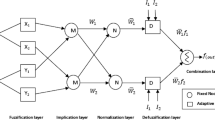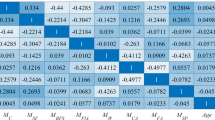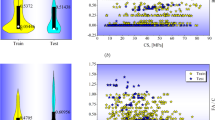Abstract
This research study presents modelling of the experimental results which evaluates the effects of RHA and PWS on concrete’s compressive strength after 28-day hydration period using ANFIS to achieve sustainable engineering works. The benefits of soft computing applications for structural materials optimization are to deal with complex problems associated with systematically incorporating admixtures in concrete production to achieve sustainable and durable engineering design. The ANFIS model was developed using 62 datasets gotten from the laboratory results with respect to varying ratios of replacement of cement and fine aggregates with RHA and PWS, respectively, from 0 to 50%. The ANFIS computation toolbox in MATLAB software was utilized for the model simulation, testing, training and validation of the mechanical behaviour of green concrete produced with varying proportions of RHA and PWS as admixture using hybrid method of optimization and grid partition method of FIS at 100 Epochs. The mixture variations of cement–RHA and fine-aggregatePWS combinations were taken as the input parameters while the output variable is the compressive strength response. The ANFIS model performance evaluation results obtained using loss function parameters showed MAE of 0.2244, RMSE of 0.625, MSE of 0.3906, and coefficient of determination value of 98.67% which indicates a good relationship between the predicted and actual results.


















Similar content being viewed by others
References
Adefemi, A., Nensok, M. H., Ka’ase, E. T., & Wuna, I. A. (2013). Exploratory study of date seed as coarse aggregate in concrete production. Civil & Environmental Research., 3(1), 85.
Agbede, O. I., & Manasseh, J. (2009). Suitability of periwinkle shell as partial replacement for river gravel in concrete. Leonardo Electronic Journal of Practices and Technologies, 15(2), 59–66.
Alaneme, G., & Mbadike, E. (2020). Modelling of the compressive strength of palm-nut-fibre concrete using Scheffe’s Theory. Computational Engineering and Physical Modeling, 3(1), 31–40. https://doi.org/10.22115/Cepm.2020.212999.1076
Alaneme, G. U., & Mbadike, E. M. (2021). Experimental investigation of Bambara nut shell ash in the production of concrete and mortar. Innovative Infrastructure Solutions, 6, 66. https://doi.org/10.1007/s41062-020-00445-1
Alaneme, G.U., Onyelowe, K.C., Onyia, M.E., Bui Van, D., Mbadike, E.M., Dimonyeka, M.U., Attah, I.C., Ogbonna, C., Iro, U.I., Kumari S., Firoozi A.A., Oyagbola I. (2020a). Modelling of the swelling potential of soil treated with quicklime-activated rice husk ash using fuzzy logic, Umudike Journal of Engineering and Technology (UJET); Vol. 6, No. 1, June 2020, pp. 1 – 22; Michael Okpara University of Agriculture, Umudike, Print ISSN: 2536–7404, Electronic ISSN:2545–5257; http://ujetmouau.net; https://doi.org/10.33922/j.ujet_v6i1_1
Alaneme, G.U., Onyelowe, K.C., Onyia, M.E., Bui Van, D., Mbadike, E.M., Ezugwu, C.N., Dimonyeka, M.U., Attah, I.C., Ogbonna, C., Abel, C., Ikpa, C.C., Udousoro I.M. (2020b). Modeling volume change properties of hydrated-lime activated rice husk ash (HARHA) modified soft soil for construction purposes by artificial neural network (ANN), Umudike Journal of Engineering and Technology (UJET); Vol. 6, No. 1, June 2020, pp. 88 – 110; Michael Okpara University of Agriculture, Umudike, Print ISSN: 2536–7404, Electronic ISSN:2545–5257; http://ujetmouau.net; https://doi.org/10.33922/j.ujet_v6i1_9
Alaneme, G. U., Ezeokpube, G. C., & Mbadike, E. M. (2020c). Failure analysis of a partially collapsed building using analytical hierarchical process. Journal of Failure Analysis and Prevention. https://doi.org/10.1007/s11668-020-01040-3
Alaneme, G.U., Onyelowe, K.C., Onyia, M.E., Bui Van, D., Dimonyeka, M.U., Nnadi E., Ogbonna, C., Odum, L.O., Aju, D.E., Abel, C., Udousoro, I.M., Onukwugha, E. (2021). Comparative modelling of strength properties of hydrated-lime activated rice-husk-ash (HARHA) modified soft soil for pavement construction purposes by artificial neural network (ANN) and fuzzy logic (FL). Jurnal Kejuruteraan, 33 (2). (in press)
Al-Rawas, A. A., Hago, A. W., Corcoran, T. C., & Al-Ghafri, K. M. (1998). Properties of Omani artificial pozzolana (sarooj). Applied Clay Science, 13, 275–292.
Amaziah, W. O., Idongesit, U. F., & Theodore, A. I. (2013). Exploratory study of crushed periwinkle shell as partial replacement for fine aggregates in concrete. Journal of Emerging Trends in Engineering and Applied Sciences, 4(6), 823–827.
AnandaKumar, K., Punithavalli, M. (2011). Efficient cancer classification using fast adaptive neuro-fuzzy inference system (FANFIS) based on statistical techniques. International Journal of Advanced Computer Science and Applications, Special Issue on Artificial Intelligence, 132–137.
Anwar, M., Miyagata, T., & Gaweesh, M. (2000). Using rice husk ash as a cement replacement material in concrete. Waste Management Series, 1, 671–684.
ASTM C125-16. (2016). Standard terminology relating to concrete and concrete aggregates. West Conshohocken: ASTM International.
ASTM C1602/C1602M-12. (2021). Standard specification for mixing water used in the production of hydraulic cement concrete.
ASTM specification C618-78. (2021). Specification for fly ash and raw or calcined natural pozzolan for use as a mineral admixture in Portland Cement Concrete.
Attah, I. C., Etim, R. K., & Sani, J. E. (2019). Response of oyster shell ash blended cement concrete in sulphuric acid environment. Civil and Environmental Research, 11(4), 62–74.
Attah, I. C., Etim, R. K., Alaneme, G. U., & Bassey, O. B. (2020). Optimization of mechanical properties of rice husk ash concrete using Scheffe’s theory. SN Applied Sciences. https://doi.org/10.1007/s42452-020-2727-y Springer Nature Switzerland AG.
Basha, E. A., Hashim, R., & Muntohar, A. S. (2003). Effect of the cement-rice husk ash on the plasticity and compaction of soil. Electronic Journal of Geotechnical Engineering, 8(1), 1–8.
Behfarnia, K., & Khademi, F. (2017). A comprehensive study on the concrete compressive strength estimation using artificial neural network and adaptive neuro-fuzzy inference system. International Journal of Optimization in Civil Engineering, 7(1), 71–80.
Bisht, D.C.S., Jangid, A. (2011). Discharge modelling using adaptive neuro - fuzzy inference system. International Journal of Advanced Science and Technology, 31.
BS 3797-1. (1964). Lightweight aggregate for concrete.
BS 12 (1978) Specification for ordinary and rapid hardening Portland cement
BS 882. (1992). Specification for Aggregates from Natural Sources for Concrete. London: British Standards Institute.
British standard (BS) 8110 part 1. (1997). Structural use of concrete, code of practice for design and construction. London: British Standard Institution.
B Standard (BS) EN 12620. (2002). Aggregates for concrete. London: British Standard Institution.
BS 8615-1. (2019). Specification for pozzolanic materials for use with Portland cement. Natural pozzolana and natural calcined pozzolana.
Chimmaobi, O., Mbadike, E. M., & Alaneme, G. U. (2020). Experimental investigation of cassava peel ash in the production of concrete and mortar. Umudike Journal of Engineering and Technology, 6(2), 10–21. https://doi.org/10.33922/j.ujet_v6i2_2.
Eberemu, A. O., Amadi, A. A., & Osinubi, K. J. (2012). The use of compacted tropical clay treated with rice husk ash as a suitable hydraulic barrier material in waste containment applications. Waste Biomass Valorization. https://doi.org/10.1007/s12649-012-9161-3
Edil, T. B., Acosta, H. A., & Benson, C. H. (2006). Stabilizing soft fine-grained soils with fly ash. Journal of Materials in Civil Engineering, 18(2), 283–294.
Elinwa, A. U., Ejeh, S. P., & Mamuda, A. M. (2008). “Assessing of the fresh concrete properties of self-compacting concrete containing sawdust ash. Construction and Building Materials, 22(6), 1178–1182.
Erdirencelebi, D., & Yalpir, S. (2011). Adaptive network fuzzy inference system modeling for the input selection and prediction of anaerobic digestion effluent quality. Applied Mathematical Modelling, 35, 3821–3832. https://doi.org/10.1016/j.apm.2011.02.015
Etim, R. K., Attah, I. C., Eberemu, A. O., & Yohanna, P. (2019). Compaction behaviour of periwinkle shell ash treated lateritic soil for use as road sub-base construction material. Journal of Geoengineering, 14(3), 179–200. https://doi.org/10.6310/jog.201909_14(3).6
Falade, F. (1992). The use of palm kernel shells as coarse aggregate in concrete. Journal of Housing Science, 16(3), 213–219.
George, U. A., & Elvis, M. M. (2019). Modelling of the mechanical properties of concrete with cement ratio partially replaced by aluminium waste and sawdust ash using artifcial neural network. SN Applied Sciences, 1, 1514. https://doi.org/10.1007/s42452-019-1504-2.
Ghiasi, M. M., Arabloo, M., Mohammadi, A. H., & Barghi, T. (2016). Application of ANFIS soft computing technique in modeling the CO2 capture with MEA, DEA, and TEA aqueous solutions. International Journal of Greenhouse Gas Control, 49, 47–54.
Jang, J. S. R. (1993). ANFIS: adaptive-network-based fuzzy inference system. IEEE Transactions on Systems, Man and Cybernetics, 23(3), 665–685.
Jang, J. S. R., Sun, C. T., & Mizutani, E. (1997). Neuro-fuzzy and soft computing, a computational approach to learning and machine intelligence. Upper Saddle River: Prentice Hall.
Job, O. F., Umoh, A. A., & Nsikak, S. C. (2009). Engineering properties of sandcrete blocks containing periwinkle shell ash and ordinary portland cement. International Journal of Civil Engineering, 1(1), 18–24.
Karaboga, D., & Kaya, E. (2019). Adaptive network based fuzzy inference system (ANFIS) training approaches: a comprehensive survey. Artificial Intelligence Review, 52, 2263–2293. https://doi.org/10.1007/s10462-017-9610-2
Kurtener, D., Krueger, E., & Torbert, H. A. (2016). Soil disturbance evaluation: Application of ANFIS. European Agrophysical Journal, 3(2), 42–55. https://doi.org/10.17830/j.eaj.2016.03.042
Li, Z. (2011). Advanced concrete technology. Hoboken: Wiley.
Massazza, F. (2001). Pozzolana and pozzolanic cements. Lea's Chemistry of Cement and Concrete. Butterworth-Heinemann: 471–636.
Mboya, H.A., King’ondu, C. K., Njau, K. N., Mrema, A.L. (2017). Measurement of pozzolanic activity index of scoria, pumice, and rice husk ash as potential supplementary cementitious materials for Portland cement. Advances in Civil Engineering, 2017, 13 pages. (Article ID 6952645)
Michael, I. O., Fidelis, I. A., & Ikpi, U. U. (2012). Mechanical properties of hybrid periwinkle and rice husk filled CNSL composite. International Journal of Nano and Material Sciences, 1(2), 74–80.
Neville, A. M., & Brooks, J. J. (2002). Concrete technology (2nd ed., pp. 8–15). Delhi: Person Education Ltd. 18–34, 363–384.
Nigerian code of practice part 1 (NCP 1). (1973). The structural use of concrete in building. Nigeria Standards Organization (p. 28). Lagos: Federal Ministry of Industries.
Ogbonna, C., Mbadike, E., & Alaneme, G. (2020). Characterisation and use of cassava peel ash in concrete production. Computational Engineering and Physical Modeling, 3(2), 11–20. https://doi.org/10.22115/Cepm.2020.223035.1091
Olanipekun, E.A., Olusola, K.O. and Ata, O. (2006). A comparative study of concrete properties using coconut shell and palm kernel shell as coarse aggregates, www.sciencedirect.com. Building and Environment, 41(20066): 297–3.
Olutoge, F. A., Oriyomi, M. O., & Olatunji, S. O. (2012). Assessment of the suitability of periwinkle shell ash (PSA) as partial replacement for ordinary portland cement (OPC) in concrete. International Journal of Research and Reviews in Applied Sciences, 10(3), 428–434.
Onwuka, D.O., Anyaogu, L., Chijioke, C., Okoye, P.C. (2013). Prediction and optimization of compressive strength of sawdust ash-cement concrete using scheffe’s simpex design. International Journal of Scientific and Research Publications, 3(5).
Onyelowe, K.C., Bui Van, D., Ubachukwu, O., Ezugwu, C., Salahudeen, B., Nguyen Van, M., Ikeagwuani, C., Amhadi, T., Sosa, F., Weiwu, Ta Duc, T., Eberemu, A., Pham Duc, T., Barah, O., Ikpa, C., Orji, F., Alaneme, G., Amanamba, E., Ugwuanyi, H., Sai, V., Kadurumba, C., Subburaj, S., Ugorji, B. (2019). Recycling and reuse of solid wastes; a hub for ecofriendly, ecoefficient and sustainable soil, concrete, wastewater and pavement reengineering. International Journal of Low-Carbon Technologies 2019, 1–12, The Author(s) 2019. Published by Oxford University Press. https://doi.org/10.1093/ijlct/ctz028
Onyelowe, K., Salahudeen, A. B., Eberemu, A., Ezugwu, C., Amhadi, T., Alaneme, G., & Sosa, F., et al. (2020). Utilization of solid waste derivative materials in soft soils re-engineering. In H. Ameen (Ed.), GeoMEast 2019, SUCI (pp. 49–57). Switzerland: Springer Nature. https://doi.org/10.1007/978-3-030-34199-2_3
Orangun, C. O. (1974). The suitability of periwinkle shells as coarse aggregate for structural concrete. Journal of Materials and Structural, 7(5), 341–346. Springer, Netherlands publisher.
Osarenmwinda, J. O., & Awaro, A. O. (2009). The potential use of periwinkle shell as coarse aggregate for concrete (pp. 62–64). Switzerland: Trans Tech Publication. Journal of Advanced Materials Research.
Oyetola, E. B., & Abdullahi, M. (2006). The use of rice husk ash in low-cost sandcrete block production. Leonardo Electronic Journal of Practices and Technologies, 8, 58–70.
Ramezanianpour, A. A., Sobhani, M., & Sobhani, J. (2004). Application of network based neuro-fuzzy system for prediction of the strength of high strength concrete. Amirkabir Journal of Science and Technology., 5(59–C), 78–93.
Sadrmomtazi, A., Sobhani, J., & Mirgozar, M. A. (2013). Modeling compressive strength of EPS lightweight concrete using regression, neural network and ANFIS. Construction and Building Materials, 42, 205–216.
Sata, V., Jaturapitakkul, C., & Kiattikomol, K. (2007). Influence of pozzolan from various by-product materials on mechanical properties of high-strength concrete. Construction and Building Materials, 21(7), 1589–1598.
Smith, D. K., Johnson, G. G., Ruud, J., & Clayton, O. (2001). Clay mineral analysis by automated powder diffraction analysis using the whole diffraction pattern. Powder Diffraction, 16, 181–185. https://doi.org/10.1154/1.1423284
Sobhani, J., Najimi, M., Pourkhorshidi, A. R., & Parhizkar, T. (2010a). Prediction of the compressive strength of no-slump concrete: A comparative study of regression, neural network and ANFIS models. Construction of Building Materials, 24, 709–718.
Sobhani, J., Najimi, M., Pourkhorshidi, A. R., & Parhizkar, T. (2010). Prediction of the compressive strength of no-slump concrete: a comparative study of regression, neural network and ANFIS models. Construction and Building Materials, 24, 709–718.
Thomas, B. S. (2018). Green concrete partially comprised of rice husk ash as a supplementary cementitious material—a comprehensive review. Renewable and Sustainable Energy Reviews, 82, 3913–3923.
Umoh, A. A., & Olusola, K. O. (2012). Effect of different sulphate types and concentrations on compressive strength of periwinkle shell ash blended cement concrete. International Journal of Engineering and Technology, 12(5), 10–17.
Wang, J., & Rahman, M. S. (2002). Fuzzy neural network models for liquefaction prediction. Soil Dynamics and Earthquake Engineering, 22(8), 685–694.
Yilmaz, I., & Yuksek, G. (2009). Prediction of the strength and elasticity modulus of gypsum using multiple regression, ANN, and ANFIS models. International Journal of Rock Mechanics and Mining Sciences, 46(4), 803–810.
Yohanna, H.S, Bang, P.D, Zakka, P.W and Anigbogu, N.A. (2019). Optimization of partial replacement of concrete coarse aggregate with crushed canarium schweinfurthii (Atili) seed shell. International Journal of Scientific and Research Publications, 9(3).
Zareei, S. A., Ameri, F., Dorostkar, F., & Ahmadi, M. (2017). Rice husk ash as a partial replacement of cement in high strength concrete containing micro silica: evaluating durability and mechanical properties. Case Studies in Construction Materials, 7, 73–81.
Zhang, M. H., & Malhotra, V. M. (1996). High- performance concrete incorporating rice husk ash as a supplementary cementing material. ACI Materials Journal, 93(6), 629–636.
Author information
Authors and Affiliations
Corresponding author
Ethics declarations
Conflict of interest
There are no recorded conflicts of interests in this research work.
Additional information
Publisher's Note
Springer Nature remains neutral with regard to jurisdictional claims in published maps and institutional affiliations.
Rights and permissions
About this article
Cite this article
Alaneme, G.U., Mbadike, E.M., Iro, U.I. et al. Adaptive neuro-fuzzy inference system prediction model for the mechanical behaviour of rice husk ash and periwinkle shell concrete blend for sustainable construction. Asian J Civ Eng 22, 959–974 (2021). https://doi.org/10.1007/s42107-021-00357-0
Received:
Accepted:
Published:
Issue Date:
DOI: https://doi.org/10.1007/s42107-021-00357-0




